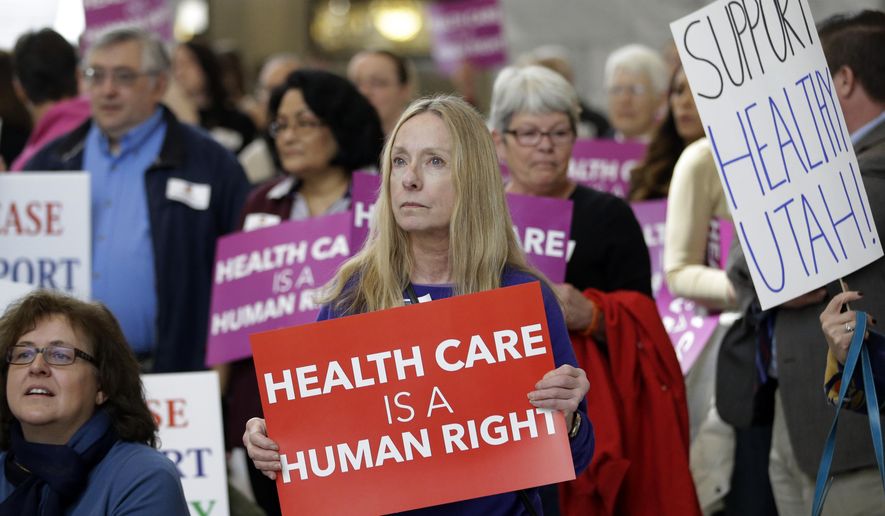It’s still far too easy for undeserving Obamacare enrollees to get taxpayer subsidies on insurance exchanges, and some customers are wrongly receiving both Medicaid and tax credits under the health care law, government auditors said Thursday in written testimony to Congress.
The findings, delivered by the Government Accountability Office to the House Energy and Commerce and Senate Finance committees, raise doubts about the program less than two weeks before Americans flock to the health care marketplace.
The findings also demonstrate that a key problem the GAO uncovered last year — that fake enrollees can get coverage — continues to be a problem.
“Our undercover testing for the 2015 coverage year found that the healthcare marketplace eligibility determination and enrollment process remains vulnerable to fraud,” wrote Seto Bagdoyan, the GAO’s director of forensic audits and investigative service.
Auditors said all 10 of their fictitious applicants were able to get coverage in state-run exchanges in California and Kentucky and federally operated exchanges in North Dakota and New Jersey, even though eight of them initially were rejected during an ID check at the front end of the system. Four of the applicants used Social Security numbers that have never been issued, auditors said.
In addition, seven out of eight fake applicants for Medicaid — the government health program for the poor — were able to obtain coverage or subsidized exchange plans instead. Their applications were buoyed by false Social Security information and, in one case, a fake immigration card. Only one applicant was denied after California demanded a Social Security or taxpayer ID number.
The Affordable Care Act established two main streams of health insurance coverage for the uninsured — Web-based exchanges where customers can shop for private plans with the help of taxpayer subsidies and expansion of Medicaid coverage in the 29 states, plus the District of Columbia, that have opted in.
Yet the GAO said the Obama administration is not doing enough to prevent people from double-dipping, as an estimated 7 million people could toggle between the programs because their incomes are so volatile. The administration also has a hard time differentiating between eligibility groups so that states get the correct amount in federal matching funds from the Centers for Medicare and Medicaid Services (CMS).
“Consequently, we concluded that CMS cannot identify erroneous expenditures due to incorrect eligibility determinations, which also limits its ability to ensure that state expenditures are appropriately matched with federal funds,” Carolyn L. Yocum, the GAO’s director of health care, said in prepared testimony.
The GAO said electronic records are not always updated in real time to reflect a person’s transition between the programs, which also may expose enrollees to gaps in coverage. Investigators said that taxpayers may be billed twice and that individuals who double-dip would be liable for Obamacare subsidies they received while on Medicaid.
As part of its separate undercover investigation, the GAO said fake applicants were able to get exchange coverage in part because officials only look for documentation that has been clearly altered.
“Thus, if the documentation submitted does not show such signs, it would not be questioned for authenticity,” Mr. Bagdoyan wrote.
The undercover operation used a mix of Web and phone applications, and obtained subsidies worth a total of $28,000 per year.
The Department of Health and Human Services noted that GAO investigators were blocked during their initial attempts to enroll and said they doubt the identified vulnerabilities would have real-world impact.
“It’s important to consider whether it’s likely that uninsured Americans would replicate the next actions the GAO took, namely knowingly and willfully providing false information in violation of federal law, which could subject the individual to up to a $250,000 fine,” HHS spokeswoman Meaghan Smith said. “It seems unlikely that many uninsured Americans, many of whom have less than $100 in savings, would choose to commit perjury in order to pay the premiums and deductibles for two insurance policies or to pay premiums for marketplace insurance when eligible for Medicaid.”
The agency noted that subsidies are paid to insurers, so enrollees cannot directly profit, and that they “remain disappointed” with the GAO for refusing to detail how they were able to penetrate their systems.
Investigators said their results are preliminary and cannot be applied to the enrollment population at large, but they’re raising red flags at a crucial time for Obamacare.
President Obama’s signature overhaul will kick off its third enrollment period Nov. 1, and officials say it is getting harder to find uninsured Americans who didn’t sign up on the exchanges during the first two rounds.
The administration predicted the exchange would attract 10 million enrollees for 2016, or less than half of the Congressional Budget Office’s projected estimate.
Meanwhile, congressional Republicans are pushing fast-track legislation that would gut Obamacare by repealing its insurance mandates and most unpopular taxes.
The bill, set for a House vote Friday, uses a budget process known as “reconciliation” to get around a Democratic filibuster in the Senate.
Although Mr. Obama can still veto what Congress produces, Republicans want to prove they can repeal Obamacare with a simple Senate majority and a GOP president in 2017.
• Tom Howell Jr. can be reached at thowell@washingtontimes.com.




Please read our comment policy before commenting.